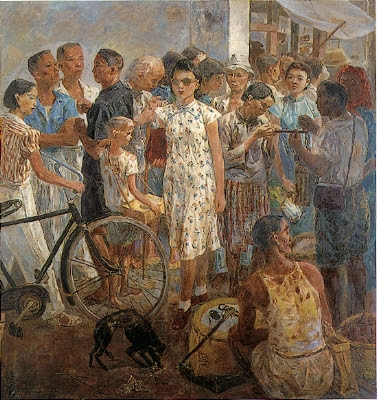Taiwan's first modern sculptor.
During his life he was selected for The Imperial Art Academy Exhibition four times.
Many of his works have disappeared due to unfavorable political circumstances in postwar Taiwan.
 |
| Source: www.lianggallery.com |
He was an impressive singer, composer, poet, and writer.
Without any formal musical training, he entered the vocal music field through competitions at age 22.
In the Art Competition at the Berlin Summer Olympics (1936), he won an Honorable Mention in the category of Orchestra with "Formosan Dance."
Lin Chao-ying (林朝英) {1739-1816}
His calligraphy is known as the "bamboo-leaf style," due to its distinct and vigorous structure.
His floral paintings are also vibrant and lively.
He created his works as a member of the literati.
 |
| Source: nicecasio.pixnet.net |
He was a professional painter.
His lively and amusing depictions of figures, flora, and birds were painted in an intuitive style.
He appears to have been deeply influenced by Huang Shen, one of the eight eccentrics of Yangchou.
 |
| Source: Wikipedia |
He was a watercolorist and interpreter for the army.
He visited Taiwan twice, making a significant artistic impact on both occasions.
He introduced Western art to the Taiwanese public through exhibitions, art clubs, and newspapers.
He taught art in the normal schools and fostered talented students.
 |
| Source: culture.teldap.tw |
She was selected for the first Taiwanese Art Exhibition in the East Asian painting category.
She was known as one of "The Three Youths of Taiten".
 |
| Source: vr.theatre.ntu.edu.tw |
He was selected for the first Taiwanese Art Exhibition in the East Asian painting category.
He was known as one of "The Three Youths of Taiten".
 |
| Source: www.lianggallery.com |
He was selected for the first Taiwanese Art Exhibition in the East Asian painting category.
He was known as one of "The Three Youths of Taiten".
 |
| Source: www.pinterest.com |
He was a renowned watercolorist.
He was famous for painting rural scenes in Taiwan.
His teacher was Ishikawa Kinichiro.
 |
| Source: www.chinigallery.com |
 |
| Source: chenchengpo.dcam.wzu.edu.tw |
 |
| Source: www.artsy.net |
 |
| Source: vr.theatre.ntu.edu.tw |
 |
| Source: www.pinterest.com |



